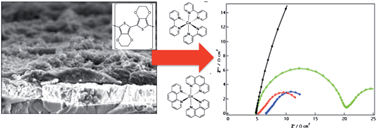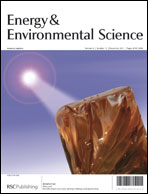We highlight the effect of the interfacial charge-transfer resistance at the counter electrode in dye-sensitized solar cells based on two cobalt redox shuttles, namely cobalt(III/II) tris(2,2′-bipyridine) and cobalt(III/II) tris(1,10-phenanthroline). Highly porous counter electrodes based on poly(3,4-ethylenedioxythiophene) (PEDOT) prepared by electro-oxidative polymerization are compared to the typically employed platinized FTO glass, with the former showing much lower charge transfer resistances for both cobalt complexes, leading to improved fill factors and to linear response of the short circuit photo-current density to light intensity up to one sun. Based on these findings, an excellent power conversion efficiency of 10.3% was achieved with a recently reported organic sensitizer and PEDOT as counter electrode.
You have access to this article
 Please wait while we load your content...
Something went wrong. Try again?
Please wait while we load your content...
Something went wrong. Try again?


 Please wait while we load your content...
Please wait while we load your content...